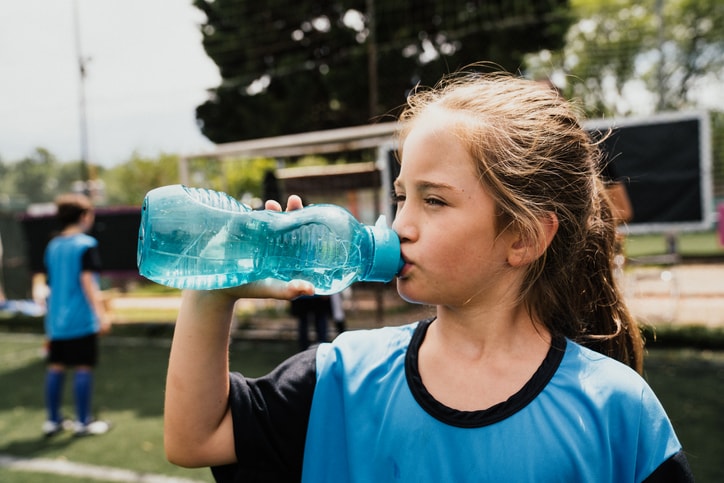With millions of followers on social media and a newly announced partnership with the popular video game Fortnite, it’s no wonder the sports drink Prime Hydration is the newest trend for kids’ hydration.
Prime’s marketing claims the drink can “refresh, replenish and refuel” for “any endeavor,” but parents may find themselves wondering what that means. Most importantly, they may find themselves wondering: Is Prime Hydration good for kids?
For parents and caregivers wondering if kids can drink Prime and under what circumstances, we’ve gathered expert opinions from pediatricians and nutritionists, as well as parents of Prime Hydration drinkers.
Is Prime safe for kids to drink?
The short answer, according to experts? Yes, Prime Hydration is generally safe for kids to drink in moderation.
According to Dr. Christina Johns, a board-certified pediatrician, based in Annapolis, Maryland, “While it is not unsafe to consume Prime Hydration in moderation, I stand by the basics [of nutrition] and encourage plenty of water as the basis for hydration in children.”
Johns, also the official spokesperson for the American Academy of Pediatrics and senior medical advisor at PM Pediatric Care, points out that Prime’s promise of hydration is not always the primary reason children want to drink them. “Because sports drinks like Prime Hydration are designed to have a pleasant, sweet flavor, it is tempting to misuse them, drinking them casually on a daily basis.”
“While it is not unsafe to consume Prime Hydration in moderation, I stand by the basics [of nutrition] and encourage plenty of water as the basis for hydration in children.”
— Dr. Christina Johns, board-certified pediatrician
What are Prime Drinks?
Prime is a company started by the popular YouTubers Logan Paul and KSI. They started the company after being amateur boxing opponents with the intention to “showcase what happens when rivals come together as brothers and business partners to fill the void where great taste meets function,” according to their website.
Both YouTubers are quite popular among children, racking up millions of views on their videos, many of which feature Prime advertisements.
“There are many products and items my children see on YouTube that they want to try, and Prime was one item I felt OK about trying,” says Olivia Dreizen Howell, mother of a 7-year-old and 4-year-old in East Northport, New York. “My younger son really likes them,” she adds.
What’s the difference between Prime Hydration vs. Prime Energy?
When considering if your child should drink Prime, it’s important to note the difference between Prime Energy Drinks and Prime Hydration Drinks. Prime Energy Drinks are labeled with “energy drink” and are sold in cans, whereas Prime Hydration Drinks are labeled “hydration drink” and sold in plastic bottles.
The most important difference, however, is that Prime Energy Drinks contain 200 milligrams of caffeine per can, making them unsuitable for children and teens, according to the American Academy of Child and Adolescent Psychiatry. Prime Hydration Drinks are flavored water with added vitamins and nutrients that are intended to give an extra boost of energy without using caffeine.
What are the ingredients in Prime Hydration Drinks?
Prime Hydration Drinks are 20 calories per bottle and contain zero added sugar. According to their website, they are 10% coconut water, which is important to note for anyone with a coconut allergy. Other ingredients include water, electrolytes like sodium, magnesium and potassium, vitamins A, B and E and the artificial sweetener sucralose.
Prime Hydration Drinks also contain Branched-Chain Amino Acids (BCAAs), which are thought to support the growth of muscle proteins, though there is little evidence to support this theory.
What are the potential risks of Prime Hydration Drinks for kids?
According to Catherine Gervacio, registered nutritionist-dietician for the E-Health Project in Arlington, Virginia, kids “don’t need the BCAAs that Prime has.” She explains, “Children and teenagers are still in their growth and development stages, and their bodies usually get a sufficient amount from food.”
Melissa Boufounos, a certified holistic nutritionist in Ontario who specializes in sports nutrition, warns that Prime’s advertising is misleading. “Because of the celebrity and athlete endorsements of Prime Hydration, teen and adolescent athletes can be easily manipulated into believing these drinks support top athletic performance when they don’t,” says Boufounos.
Boufounos also points out that while Prime Hydration Drinks do include vitamins, that doesn’t necessarily mean they’re healthy. “Supplemental vitamin A can be harmful in excessive amounts,” she says, explaining that “Prime Hydration provides 100% of the daily value of vitamin A, so if children are consuming more than one per day, eating other foods fortified with vitamin A or using a multivitamin that provides vitamin A, they could easily exceed the upper limit.”
Both Gervacio and Boufounos listed potential excess in electrolytes as a risk factor for kids. “Prime Hydration Drinks are designed to replenish electrolytes but are tailored to meet the needs of adults,” says Gervacio. “Children and teens don’t need such high amounts so they may suffer from electrolyte imbalance, which affects kidney function and blood pressure.”
“Prime Hydration Drinks are designed to replenish electrolytes but are tailored to meet the needs of adults.”
— Catherine Gervacio, registered nutritionist-dietician
What are the potential benefits of Prime Hydration Drinks for kids?
While there are potential risks for kids regularly consuming Prime Hydration Drinks, the drinks can be beneficial for children and teens engaging in strenuous physical activity, like competitive sports.
“Athletes who use sports drinks properly may see improvement in overall wellness and athletic performance in terms of enhanced stamina or conditioning,” says Johns.
Chris Pruitt, a parent in Gaithersburg, Maryland, says his 8-year-old drinks Prime Hydration Drinks during swim meets, “as part of his athletic routine.” Pruitt has noticed that “the drink seems to give him a burst of energy and helps quench his thirst.” He adds, however, that his son also eats other snacks during the meets, so it’s “challenging to attribute the effects solely to Prime.”
Especially for times when kids may be at risk of dehydration (hello, flu season), Prime’s promise of hydration — in flavors like Strawberry Watermelon and Tropical Punch — can be another potential advantage of the drink.
“One possible benefit of children consuming Prime Hydration drinks is that they are drinking hydrating fluids,” says Boufounos. For kids who resist drinking regular water, Prime could encourage them to hydrate more because of the exciting flavors.
Alex Morgan, a parent of three in Idaho, says he gives his children Prime Hydration Drinks when they’re sick in order to keep them hydrated. “Our kids love Prime, which helps them to want to drink fluids while they aren’t feeling well,” he says, adding, “Without Prime, it is much more difficult to get them to drink and stay hydrated during these times.”
Morgan does note, however, that his children, who are 6, 3 and 1.5, only drink Prime when dehydrated from illness or sports.
Should kids drink Prime Hydration Drinks?: What experts say
In general, Johns, Gervacio and Boufounos agree that Prime Hydration Drinks are not ideal for children and may even have some potential risk factors if consumed inappropriately.
According to experts, the risk factors involved with Prime Hydration Drinks are heightened based on how often they consume the drink and in what situations. If kids consume more than one per day, they may be consuming too much vitamin A or be at risk for electrolyte imbalance, as Boufounos and Gervacio pointed out.
Across the board, though, the experts’ main critique of Prime is that its benefits are not all that different from the benefits of drinking regular water.
“Water plus a well-balanced diet with plenty of fruits and vegetables ensures that kids get both the electrolytes they need, as well as adequate hydration,” explains Johns.
Along the same lines, Gervacio recommends giving kids fruits or fruit juices, along with water, to replenish electrolytes.
“You might as well save your money and just drink water,” adds Boufounos.
“You might as well save your money and just drink water.”
— Melissa Boufounos, certified holistic nutritionist
Gervacio does say a case can be made for Prime Hydration as a good source of hydration for teens, who are engaging in intense physical activity. “Teens may benefit from it only if they are engaged in heavy and prolonged physical activity because of an increased sweat rate,” she says.
Johns warns this may not be the case for younger kids participating in sport. “It’s also important to be realistic about whether or not a child does indeed perform such strenuous activity that they lose a clinically significant amount of electrolytes,” she explains. “Certainly, for most younger children, that is rarely the case.”
How to talk to kids and teens about Prime Hydration Drinks
When talking to kids and teens about Prime Hydration consumption, Johns says, “parents should explain the primary function of sports drinks and reiterate the importance of proper use — intermittently during or after intense physical activity.”
She adds, “Remind children and teens that these drinks are safe in moderation but should not be consumed as a replacement for water.”
Because every kid is different and has different needs, Gervacio recommends checking in with a child or teen’s pediatrician before consuming Prime Hydration Drinks. “It is important to discuss this with a healthcare professional if sports drinks are truly needed,” as well as how much they should consume, depending on their age and actual needs.






